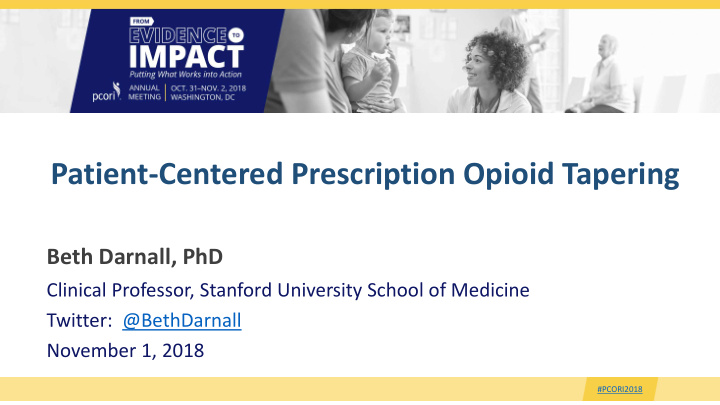



Patient-Centered Prescription Opioid Tapering Beth Darnall, PhD Clinical Professor, Stanford University School of Medicine Twitter: @BethDarnall November 1, 2018 #PCORI2018
Beth Darnall, PhD Disclosures Relationship Companies Federal Grants & • PCORI (PI) Patient-Centered Opioid and Pain Reduction Contracts Comparative Effectiveness) • NIH / NCCIH: R01 (Co-PI) Mechanisms & Efficacy of Pain Catastrophizing Treatment for Chronic Pain • NIH / NICHHD: (Stanford Site PI) Advisory Board AppliedVR, Clinical Pain Advisor , Axial Healthcare Ownership Interests Optimized Psychology Consulting 2 • November 21, 2018
BETH DARNALL
Objectives At the conclusion of this activity, the participant should be able to: • Describe the current landscape regarding opioid de-prescribing for chronic pain • Describe patient-centered approaches to prescription opioid use, opioid tapering, and pain management 4 • November 21, 2018
2011 IOM Report: Relieving Pain in America • 100 million Americans have ongoing pain • $635 billion annually • Erodes quality of life, confers suffering
5.4 % of the U.S. population 17.8 Million Mojtabai R 2017
Prescription Opioid Risks • Opioid sales associate with opioid-related mortality • Iatrogenic risks Darnall et al, Arch Int Med 2012 ( JAMA Int Med ) Darnall et al, Pain Med 2012
PATIENT-CENTEREDNESS
IASP Definition of Pain Pain Definition: A noxious sensory and emotional experience
Cognitive Behavioral Therapy for Chronic Pain Topics and Skills Pain and the brain • Diaphragmatic Breathing • • Goal setting Relaxation Response • Mood and pain • • Problem solving • Cognitive Restructuring • Sleep and pain • Movement Pleasant activities • Mindfulness • Social connection •
Stopping Opioids Patients’ number one concern/fear? Not Interested!
Tapering the wrong way • Withdrawal Symptoms Aggressive • Discomfort Taper Distress • Attrition • Forced • Failed tapers Taper • False belief that outpatient tapering is impossible Remaining on opioids indefinitely •
Community-Based Solutions are Needed • Low-cost • Low-risk • Scalable • Effectively reduces health risks • Provides education and support • Structured • Addresses anxiety of patients and prescribers alike • Promotes trust and a good doctor-patient bond
Opio i d Reduction vs. Opioid Cessiation VS.
Study Variables • Demographics (Gender, Age) Pain Treatment History (Pain Dx, Duration of Opioid Use) • • Opioid Dose (MEDD) • Average Pain Intensity (0-10) 16 Weeks • Pain Catastrophizing Scale PROMIS Measures • • Marijuana use (Y/N)
Sample Characteristics (N=51) • 55% female • 52 years of age (range = 25 – 72) • 6 years on opioids (range = 1 – 38) • Moderate pain intensity • Marijuana: 37% (18) • Opioid MEDD = 288 (60, 1005) Darnall BD , Ziadni MS, Mackey IG, Kao MC, Flood P (FEB 2018; JAMA Int Med)
Variable Baseline 16 weeks P-val Kruskal-Wallis rank sum test Median (IQR) Median (IQR) Median (IQR) Opioid Dose (MEDD) 288 (153, 587) 150 (54, 248) 0.002 Pain Intensity (NRS) 5.0 (3.0, 7.0) 4.5 (3.0, 7.0) 0.29 22 (10, 30) 15 (7, 23) 0.04 PCS (catastrophizing) 61 (54, 65) 59 (51, 65) 0.64 Fatigue 60 (53, 64) 54 (46, 62) 0.06 Anxiety 56 (49, 64) 55 (48, 61) 0.31 Depression 59 (54, 70) 56 (50, 64) 0.13 Sleep Disturbance 63 (58, 67) 63 (57, 67) 0.44 Pain Interference 60 (57, 63) 59 (56, 64) 0.47 Pain Behavior 39 (34, 41) 39 (34, 43) 0.78 Physical Function
Comparative Effectiveness of Pain Cognitive Behavioral Therapy and Chronic Pain Self- Management Within the Context of Opioid Reduction Darnall BD (Principal Investigator) • $8.8M • Funded by PCORI
1365 patients taking long term opioids for chronic pain • Stanford Pain Management Center (CA) • Stanford Primary Care (CA) • Intermountain Health (Salt Lake City) • Veterans Affairs (Phoenix) • Dr. Stieg (Frisco, CO)
Patient invited to study Optimize expectations for a successful taper Chronic Pain Self-Management Program • Two certified trained Enrollment, Baseline Survey peer leaders Treatment Group Allocation Co-Create Patient-Centered Opioid Taper Follow-Ups every 3 weeks
Patient Stories
Colleagues and Collaborators Sean Mackey, MD, PhD Kate Lorig, PhD Luana Colloca, MD, PhD Jesmin Ram Wendy Schadle Maisa Ziadni, PhD Lanja Sinjary Anu Roy, MA Pamela Flood, MD Ming-Chih Kao, PhD, MD Lu Tian, PhD Heather King, PhD Ian Mackey Joel Porter, MD Sophia You, PhD Aram Mardian, MD Penney Cowan Corinne Jung, PhD Ming-Chih Kao, PhD, MD Mark McGovern, PhD Richard Stieg, MD, MPH Tarah Venn, RD Korina DeBruyne, MD Phil Lavori, PhD
Learn More • www.pcori.org • info@pcori.org • #PCORI2018 • https:// empower. s tanford.edu 39 • November 21, 2018
Thank You! Beth Darnall, PhD Clinical Professor Stanford University School of Medicine Twitter: @BethDarnall 40 • November 21, 2018
Recommend
More recommend